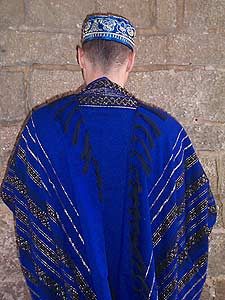Last week I was a bit surprised to get an inquiry asking whether we could provide someone with a camouflage tallit.
Hi. I’m a soldier (U.S.) and was thinking of getting a tallis in a camouflage pattern, or that somehow incorporates it. I spoke with a frum chaplain and he knew of one supplier, but they only made them in UCP, also known as “digicam,” the fabric pattern the U.S. Army is currently phasing out. Would you be able to produce one in OCP, that is, in the camo currently used by the U.S. Army? And if so, can I get an estimate?
I explained to the soldier that perhaps we could probably make arrangements with a manufacturer to produce a tallit which meets that description, but we would have to order at least 500, not one! Then, just as a quick addendum, I mentioned that he should keep in mind that when the base color is not white, it can be problematic from a halachic standpoint. He asked for more information on the topic. All I could really recall off the top of my head was that the Rambam holds the tzitzit strings should be the same color as the tallit or tallit katan garment, i.e. if if the beged is orange, the tzitzit must be orange, if the beged is yellow, the tzitzit must by yellow, if the beged is green, the tzitzit must be green.
He then asked: “…[A]re those army-green tzitzis one sees nowadays similarly problematic? Or does this only apply to the tallit gadol?” I replied that the halacha would apply the same regardless of the type of beged. I once hypothesized that combat soldiers have a second reason to have khaki tzitzit strings: venishmartem. White tzitzit flashing at your hips is not a good idea for soldiers who could be exposed to enemy fire, chalila. (In many IDF combat units soldiers can get in trouble if they have a white undershirt showing a bit above their top shirt button.) But to the best of my knowledge, nobody has gone out and done a production line of khaki tzitzit strings!

Then last night I took a look at the halacha. I found that the Beit Yosef cites the Rambam, saying that those who are punctilious make sure their tzitzit strings are the same color as the garment.
יש אומרים שצריך לעשות הציצית מצבע הטלית והמדקדקים נוהגים כן
However, the Rema, who is considered one of the main authorities for Ashkenazim, writes that the custom is to always tie on white tzitzit, even if the garment is not white (see end of Siman 9).
האשכנזים אין נוהגים לעשות הציצית רק לבנים אף בבגדים צבועים, ואין לשנות
Apparently this explains why nobody has promoted my grand scheme for khaki tzitzit strings! The Aruch HaShulchan, who is a more contemporary Ashkenazi authority, concurs with the Rema, but adds that it’s best if the tallit or tallit katan is white in order to fulfill the opinion of the Rambam as well, saying that many upright Jews adhere to this.
Reading between the lines, I got the sense that a tallit or tallit katan with a base color other than white was not so uncommon in their times. The Aruch HaShulchan ends with a parenthetical remark saying that the fact that we make the edge of the tallit sky blue and call it techelet is merely for aesthetic purposes. It’s hard for me to picture the design he’s describing. Perhaps he means a stripe not far from the edge, something like the thick band you find on most tallits today, and it might not have been celeste blue, but a darker blue. He wrote צבע הרקיע, and since according to at least one opinion techelet is the color of the sky at dusk, perhaps he was referring to dark blue.
The Mishna Brura (s.v. 16) also mentions this, noting that it’s not an issue having color on the corners because we go according to the primary color of the whole tallit (or tallit katan).


(1) Comments
What about Pikuach Nefesh? Wouldn’t it be preferable to wear the tzitzit in khaki than risk subjecting the soldier to (chas v’chalilah) enemy fire?
Comments are closed.